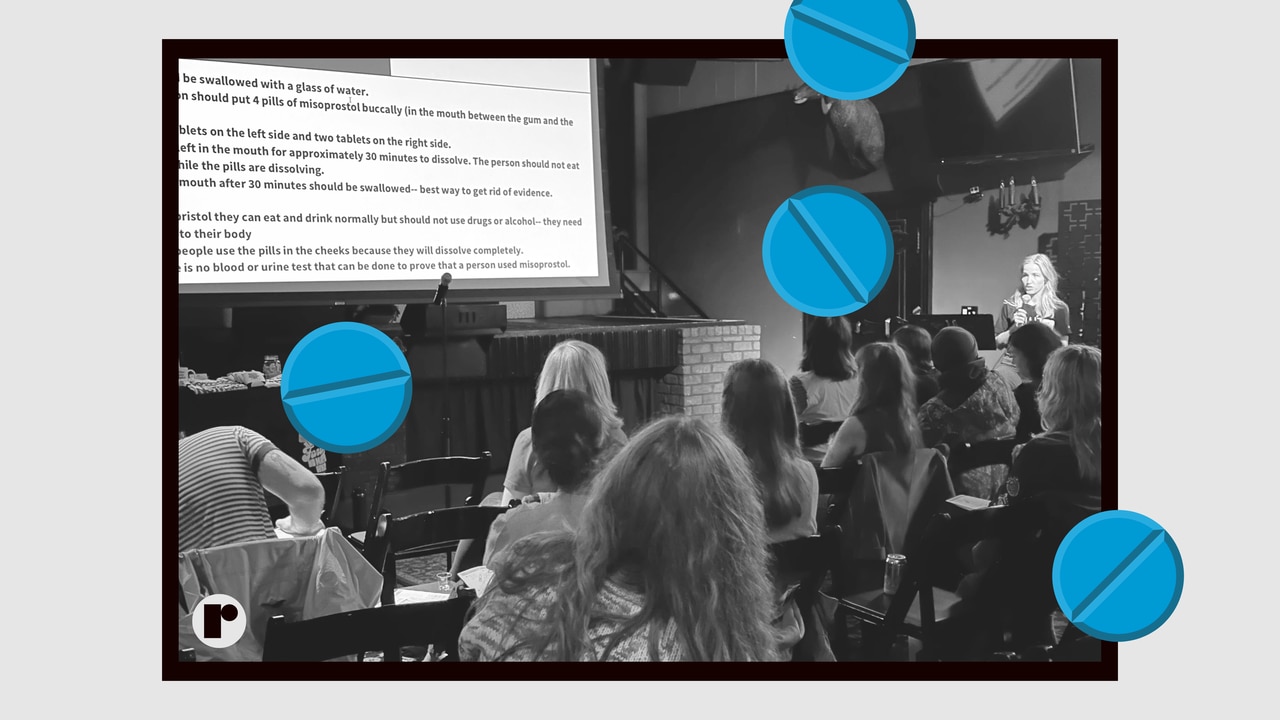Welcome to the school of self-managed abortion
In the grand scheme of things, 30 minutes does not seem like a long time, until you have to hold pills—or, for our purposes, M&Ms, from the limited edition all-female pack—in your cheeks while a timer slowly ticks down.
The M&Ms, distributed in tiny plastic cups at the beginning of the workshop, are meant to simulate the four tabs of misoprostol that are taken by either letting them dissolve inside the cheeks, under the tongue, or inserting the pills vaginally (which, these days, is not recommend in states where self-managing abortion is illegal, because it is the only method that potentially leaves behind evidence). The pills are taken the day after one ingests 200 mg of mifepristone. Pain medication is recommended ahead of the dose of misoprostol, which kickstarts the process of expelling tissue from the uterus. Welcome to the school of self-managed abortion.
It’s a Saturday afternoon in downtown Nashville, Tenn., at the end of a hellish week, and somewhere between 15 and 20 people are sitting on plastic chairs, bathed in black-and-blue shadows, gazing at slides on a projector screen. Most often, The Blue Room is venue for musical acts, nestled among Jack White’s famous record store and recording studio. Robyn Baldridge, cofounder and development coordinator of Abortion Care Tennessee, is perched on a stool at the front of the room, wearing a T-shirt that says “AIN’T AFRAID,” a nod to Jessi Zazu, a beloved local artist and lead singer of Those Darlins who died of cervical cancer in 2017. The attendees, mostly female, are that certain subsect of grungy-stylish, many sporting chic eyewear and worn tote bags. Before launching into the training on self-managed abortion, Baldridge grins broadly and says, “What y’all don’t know is that you’re living in my dream sequence right now.” Community care like this, she adds, is everything, and this sort of workshop has always been part of ACT’s vision, especially for a post-Roe future.
Baldridge reviews the slides at a quick clip. The presentation, created by the Beyond Roe Collective, is straightforward, and it comes with clear illustrations for how to self-manage one’s abortion with either the Food and Drug Administration-approved regimen of mifepristone and misoprostol, or with misoprostol alone. There aren’t a ton of questions about the process, because it seems so simple, if not entirely pleasant. We chuckle at each other’s chipmunk cheeks as chocolate slowly melts down our throats.
But as the class continues, the reality of why we’re all sitting in The Blue Room starts to sink in, and more hands wave in the air. There are some questions about the process of safely self-managing an abortion, but as time passes, the questions become more about how to gauge the legal risks. Most in the room are aware that the day before, Judge Matthew Kacsmaryk issued a ruling that declares that the FDA improperly approved mifepristone, while a Washington State judge, Thomas O. Rice, ordered the FDA to preserve access to mifepristone. It is, in legal parlance, an unprecedented clustercuss. Baldridge emphasized that Kacsmaryk’s ruling does not take immediate effect, and that no one really knows what will happen next.
That uncertainty proves to be a theme for much of the question-and-answer portion of the class. We swap tips for using encrypted messaging apps and seeking abortion pills online (use a private browser, clear your search history), debate the safest ways to request an ultrasound after the abortion, and generally worry about what could come next. There are questions about federal jurisdiction versus state and local jurisdiction, how much power the Biden administration really has to protect Americans in states like Tennessee, where power is firmly in the hands of anti-abortion politicians, and whether it’s a good idea to consider traveling out of state, even to just take the pills and self-manage. (On that last point, I get the impression that the majority of the women in the class have traditionally been sticklers for rules, and that this is their first real foray into considering what it would look like to have to break the law.)
“The questions are valid, and knowledge is power—we want to have all the information possible,” Baldridge says. “But a lot of the reason we want to do these community-led trainings is because lawmakers in general are not showing up for us right now. With that understanding, even if we do have a DA that says that they won’t prosecute you, how much can we count on that?”
The answer to so many of the questions, too, is that the legal landscape is murky, and it’s hard to know what will come next. But abortion funds like ACT are trying to be prepared for anything, and to equip their communities as best they can in the face of uncertainty.
